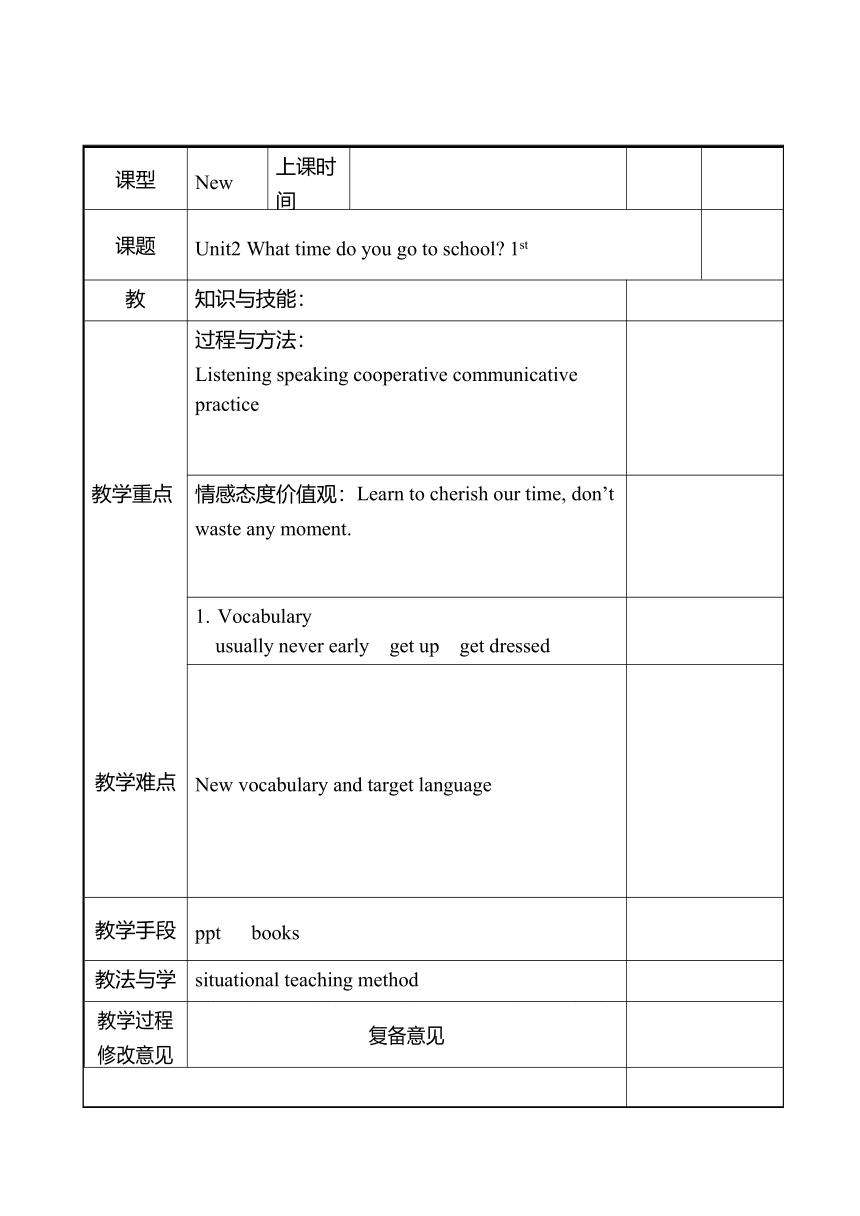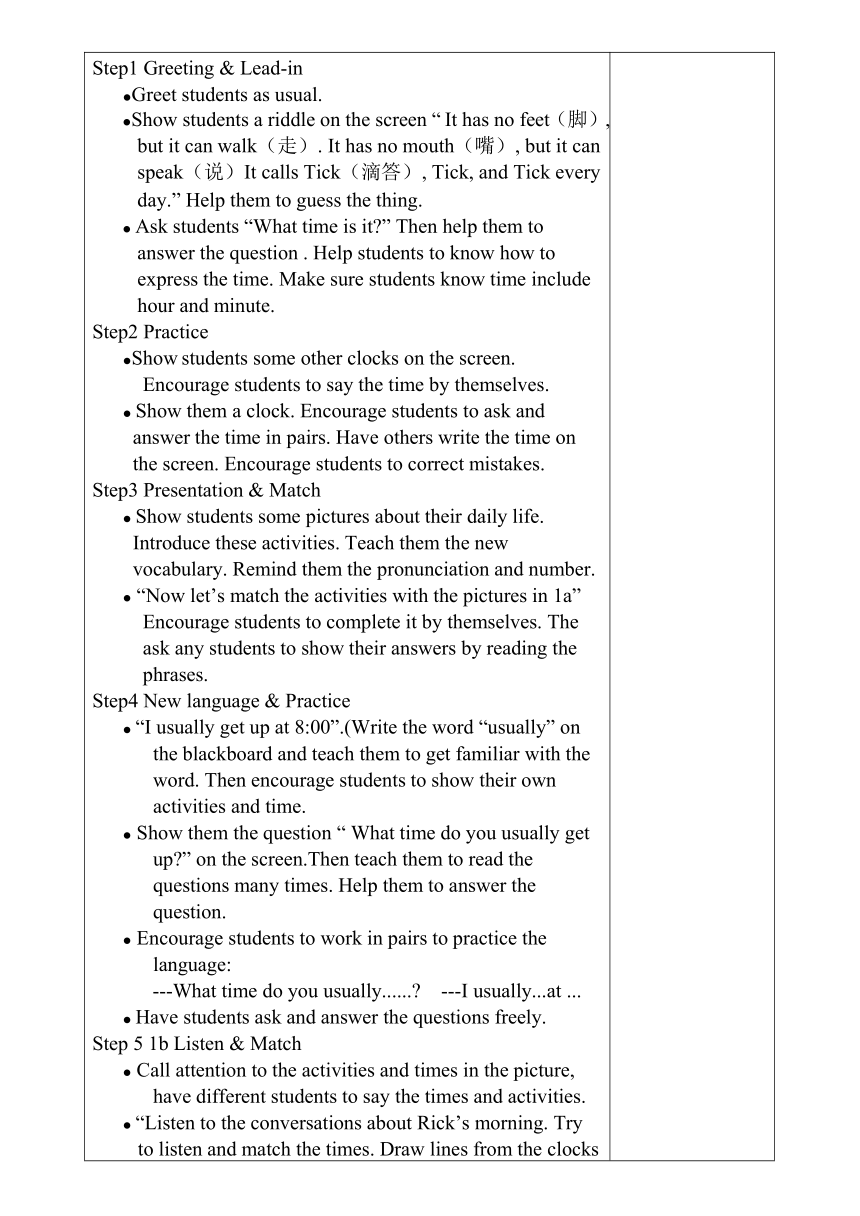人教新目标版英语七年级下Unit 2 What time do you go to school?教案(1课时)
文档属性
| 名称 | 人教新目标版英语七年级下Unit 2 What time do you go to school?教案(1课时) |  | |
| 格式 | doc | ||
| 文件大小 | 58.0KB | ||
| 资源类型 | 教案 | ||
| 版本资源 | 人教新目标(Go for it)版 | ||
| 科目 | 英语 | ||
| 更新时间 | 2022-03-16 22:32:45 | ||
图片预览


文档简介
Step1 Greeting & Lead-in ●Greet students as usual.●Show students a riddle on the screen “ It has no feet(脚), but it can walk(走). It has no mouth(嘴), but it can speak(说)It calls Tick(滴答), Tick, and Tick every day.” Help them to guess the thing.● Ask students “What time is it ” Then help them to answer the question . Help students to know how to express the time. Make sure students know time include hour and minute.Step2 Practice ●Show students some other clocks on the screen. Encourage students to say the time by themselves. ● Show them a clock. Encourage students to ask and answer the time in pairs. Have others write the time on the screen. Encourage students to correct mistakes.Step3 Presentation & Match ● Show students some pictures about their daily life. Introduce these activities. Teach them the new vocabulary. Remind them the pronunciation and number. ● “Now let’s match the activities with the pictures in 1a” Encourage students to complete it by themselves. The ask any students to show their answers by reading the phrases.Step4 New language & Practice ● “I usually get up at 8:00”.(Write the word “usually” on the blackboard and teach them to get familiar with the word. Then encourage students to show their own activities and time. ● Show them the question “ What time do you usually get up ” on the screen.Then teach them to read the questions many times. Help them to answer the question. ● Encourage students to work in pairs to practice the language:---What time do you usually...... ---I usually...at ... ● Have students ask and answer the questions freely.Step 5 1b Listen & Match ● Call attention to the activities and times in the picture, have different students to say the times and activities. ● “Listen to the conversations about Rick’s morning. Try to listen and match the times. Draw lines from the clocks to the pictures.” Play the tape for the first time, students just listen. Then play it a second time, students try to match them by themselves. ● Check answers. Step 6 Ask & Answer ● “Student A is the interviewer. Student B is Rick. Ask and answer questions about Rick’s day.” ● Ask then to read the sample conversation. Then encourage them to work in pairs. ● “What time does Rick usually get up ” Help them to answer the question. “He usually gets up at...” Show the conversation on the screen. Then encourage them to work in pairs again using the third person. ● Show.Step 7 2a Listen & Complete ● Call attention to the picture. Ask students to describe it. “ Jim has...” ● “Listen to the conversation and complete the sentences.” Play the tape for the first time students try to fill in the blanks. Check the answers by asking them to read the sentences. Remind them the word “has”.Step 8 2b Listen & Complete ● Call attention to the schedule in 2b. Remind them of name and time. “ You will listen to the tape again. Try to complete the shower schedule for Jim’s family.” Then play the tape for a second time, students try to complete the chart. Pause if necessary. ● Next, play the tape another time. Encourage students to imitate the conversation after tape. Step 9 Fill & Talk ● Show students a chart on the screen. Encourage time to fill in the chart about their own time schedules by themselves. ● Ask them to read the conversation in 2c. Then encourage them to work in pairs again to talk about themselves. Show their conversations.Step 10 Notes & Practice ● Show them the differences between the frequency words. Ask them to take notes. Then encourage them to do the exercise. ● Show then some practice on screen. Ask them to complete them by themselves. Check answers. Encourage them to give their reasons.Step 11 Summary ● Help students to review the key points of this period. “Today we’ve talked about the activities in our lives and times. We all need to Learn to cherish our time, don’t waste any moment.”
小结提高 Today we’ve learnt about our daily activities in the morning. They are “get up……”. And we’ve learnt how to ask and answer the times. The time expressions include hours and minutes. When we talk about them. We can say the hours first, then we say the minutes.Time is precious we should learn to cherish our time.第三课时1、一般地,设a是一个正数,数轴上与原点的距离是a的点有两个,它们分别在原点左右,表示-a和a,那么称这两个点关于原点对称,如下图: 像这样只有符号不同的两个数叫做互为相反数,例如6和-6,2和-2,都是互为相反数,也就是说6的相反数是-6,-2的相反数是2.2、随堂练习。3、小结。4、课后作业。
板书设计 Unit2 What time do you go to school 1stWhat time do you usually get up I usually get up at 6:30.21教育名师原创作品What time does she\he usually get up She\He usually gets up at 6:30.2
教学反思 优点:缺点:改进措施:
作业布置 Try to memorize new vocabulary and target language.Make several conversations.Read 2d three times.
课型 New 上课时间
课题 Unit2 What time do you go to school 1st
教学目标 知识与技能:new vocabulary target language listening speaking cooperative communicative practice
教学重点 过程与方法:Listening speaking cooperative communicative practice
情感态度价值观:Learn to cherish our time, don’t waste any moment.
Vocabularyusually never early get up get dressed brush teeth take a shower【版2.Target language What time do you usually get up I usually get up at 6:30.21教育名师原创作品What time does she\he usually get up She\He usually gets up at 6:30.2
教学难点 New vocabulary and target language
教学手段 ppt books
教法与学法 situational teaching method listening speaking practicing cooperative methods
教学过程修改意见 复备意见
小结提高 Today we’ve learnt about our daily activities in the morning. They are “get up……”. And we’ve learnt how to ask and answer the times. The time expressions include hours and minutes. When we talk about them. We can say the hours first, then we say the minutes.Time is precious we should learn to cherish our time.第三课时1、一般地,设a是一个正数,数轴上与原点的距离是a的点有两个,它们分别在原点左右,表示-a和a,那么称这两个点关于原点对称,如下图: 像这样只有符号不同的两个数叫做互为相反数,例如6和-6,2和-2,都是互为相反数,也就是说6的相反数是-6,-2的相反数是2.2、随堂练习。3、小结。4、课后作业。
板书设计 Unit2 What time do you go to school 1stWhat time do you usually get up I usually get up at 6:30.21教育名师原创作品What time does she\he usually get up She\He usually gets up at 6:30.2
教学反思 优点:缺点:改进措施:
作业布置 Try to memorize new vocabulary and target language.Make several conversations.Read 2d three times.
课型 New 上课时间
课题 Unit2 What time do you go to school 1st
教学目标 知识与技能:new vocabulary target language listening speaking cooperative communicative practice
教学重点 过程与方法:Listening speaking cooperative communicative practice
情感态度价值观:Learn to cherish our time, don’t waste any moment.
Vocabularyusually never early get up get dressed brush teeth take a shower【版2.Target language What time do you usually get up I usually get up at 6:30.21教育名师原创作品What time does she\he usually get up She\He usually gets up at 6:30.2
教学难点 New vocabulary and target language
教学手段 ppt books
教法与学法 situational teaching method listening speaking practicing cooperative methods
教学过程修改意见 复备意见
同课章节目录
- Unit 1 Can you play the guitar?
- Section A
- Section B
- Unit 2 What time do you go to school?
- Section A
- Section B
- Unit 3 How do you get to school?
- Section A
- Section B
- Unit 4 Don't eat in class.
- Section A
- Section B
- Unit 5 Why do you like pandas?
- Section A
- Section B
- Unit 6 I'm watching TV.
- Section A
- Section B
- Review of Units 1-6
- Unit 7 It's raining!
- Section A
- Section B
- Unit 8 Is there a post office near here?
- Section A
- Section B
- Unit 9 What does he look like?
- Section A
- Section B
- Unit 10 I'd like some noodles.
- Section A
- Section B
- Unit 11 How was your school trip?
- Section A
- Section B
- Unit 12 What did you do last weekend?
- Section A
- Section B
